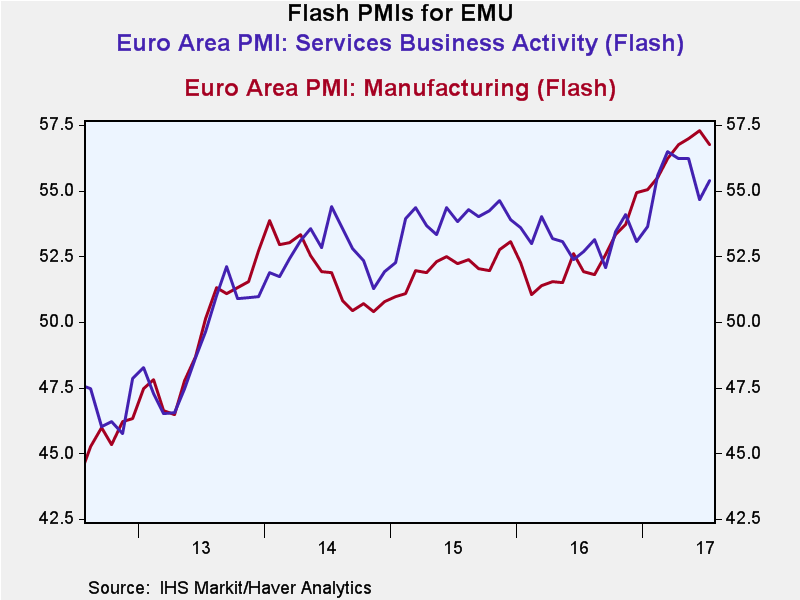 Global| Jul 24 2017
Global| Jul 24 2017European PMIs Soften; IMF Holds Line on Global Forecast But Cuts U.S. and U.K.
Summary
New data but not much change The main story about the EMU PMIs this month is still plain vanilla. The message is that PMI readings are still strong in the EMU. The overall gauge did weaken on a softer manufacturing sector as the [...]
 New data but not much change
New data but not much change
The main story about the EMU PMIs this month is still plain vanilla. The message is that PMI readings are still strong in the EMU. The overall gauge did weaken on a softer manufacturing sector as the services reading remained unchanged. The overall PMI ranked over the last five-plus years has been higher only about 8% of the time. Both manufacturing and services have 90th-plus percentile standing in their respective queues of data on the same timeline.
Both France and Germany saw their respective composite PMI readings erode in July, but for different reasons. In Germany, both manufacturing and services weakened in July. In France, services weakened but manufacturing improved; the services deterioration dominated the impact on the composite in France.
The German and French economics continued to show some very different characteristics. While Germany has a higher raw manufacturing diffusion gauge than either France or the EMU, the French percentile standing for manufacturing is higher when ranked over the past five-plus years (since January 2012). And while services have a 90th percentile standing in both France and the EMU, the German raw diffusion reading for services is the lowest of the lot with a 35th percentile standing, remarkably weak. The German services (and headline gauges) are the only metrics in the table that are weaker that their respective 12-month averages.
Japan
Japan's manufacturing index has slipped again in July and it is weaker than its three-month and six-month averages but is above its 12-month average. Japan's manufacturing gauge has a moderate 64th percentile standing in its historic queue of data.
U.S.
After a series of slippages, the Markit gauges for the U.S. are stronger in July. The overall manufacturing and services gauges all are better than their three-month averages in July and all but manufacturing are also better than their six-month averages. The U.S. readings show the composite with a queue standing in its 43rd percentile, manufacturing in its 46th percentile and services at its median value with a 50th percentile standing. The U.S. gauges continue to show activity is slightly below its historic median in most respects, but being below its median is not the same as saying that it is contracting. The absolute diffusion indexes are still above 50, signaling expansion in both sectors as well as overall.
IMF refreshes its World Economic Outlook (details here)
The IMF released a new set of economic projections today. While its overall outlook is unchanged, there are country and regional area differences; however most of them are quite small and not suggestive of any real change. The overall global growth rate of 3.5% for 2017 and 3.6% for 2018 that was established in its April outlook is being kept by the IMF. However, the growth outlook for the U.S. and the U.K. has been reduced while the outlook for Japan and China has been lifted. Growth in the U.S. is revised lower to 2.1% from 2.3% for 2017 and revised again, this time more substantially, to 2.1% from 2.5% in 2018. The IMF is losing its fiscal policy optimism on the United States. The U.K. growth outlook has been cut significantly to 1.7% from 2.0% for 2017, with the 2018 outlook for 1.5% growth being unaffected. Japan and China's growth rates each have been kicked up just a notch by 0.1% point in 2017, to 6.7% in China and to 1.3% in Japan. The IMF has cut its outlook for oil prices since April by 7.7% in 2017 with a slight, 0.4% bump up for 2018 (compared to its previous forecast). The IMF has lowered the profile on advanced economy inflation to 1.9% in 2017 and to 1.8% in 2018; each of these is 0.1 percentage point lower than its previous forecast. Thus, the IMF does not see an inflation rationale for central banks to be boosting rates. On balance, the IMF sees few real changes and a lot of very slow-motion shifting in progress. It does see the average six-month euro-dollar interest rate up to 1.6% in 2017 from 1.1% in 2016 and then rising to 2.2% for 2018 on average. In contrast to what markets seem to be expecting from the ECB, the IMF has euro area three-month deposit rates at -0.3% in 2016 and 2017 and only up to -0.2% in 2018, all the same as in its previous forecast.

Robert Brusca
AuthorMore in Author Profile »Robert A. Brusca is Chief Economist of Fact and Opinion Economics, a consulting firm he founded in Manhattan. He has been an economist on Wall Street for over 25 years. He has visited central banking and large institutional clients in over 30 countries in his career as an economist. Mr. Brusca was a Divisional Research Chief at the Federal Reserve Bank of NY (Chief of the International Financial markets Division), a Fed Watcher at Irving Trust and Chief Economist at Nikko Securities International. He is widely quoted and appears in various media. Mr. Brusca holds an MA and Ph.D. in economics from Michigan State University and a BA in Economics from the University of Michigan. His research pursues his strong interests in non aligned policy economics as well as international economics. FAO Economics’ research targets investors to assist them in making better investment decisions in stocks, bonds and in a variety of international assets. The company does not manage money and has no conflicts in giving economic advice.






